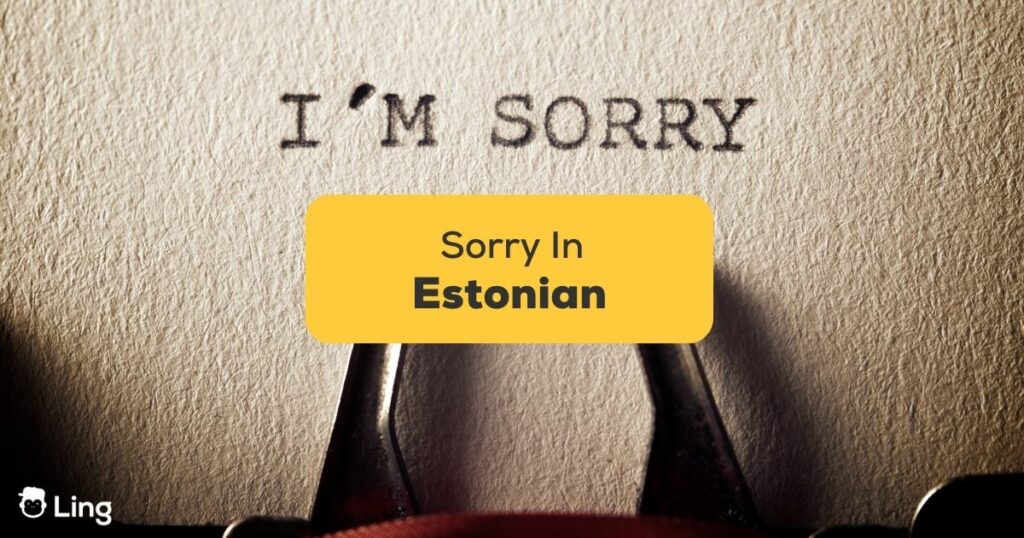Imagine you’re strolling around Tallinn’s picturesque Old Town, and you accidentally bump into someone. What do you do? If you’re a language enthusiast—or just polite—you’ll want to know how to say sorry in Estonian. We’ve got you covered! In this engaging and informative blog post, you’ll learn different ways to apologize in Estonian, so you can be both respectful and linguistically adventurous in this Baltic gem of a country.
How To Say Sorry In Estonian
The most common way to say sorry in Estonian is “vabandust” (vah-bahn-doost). One of the reasons “vabandust” is so useful is because of its versatility. It’s polite, it’s sincere, and it adapts to a range of situations. Here are some scenarios where this word might be the perfect fit:
- You’re at a bustling market and you gently knock over a stack of apples: “Vabandust, ma ei näinud neid õunu!” (“Sorry, I did not see those apples!”)
- You’re at a café and you accidentally take someone’s drink: “Vabandust, ma arvasin, et see on minu jook!” (“Sorry, I thought this was my drink!”)
Confused about a street sign or a menu? Need directions or some local advice? Don’t fret! When used correctly, “vabandust” serves as an effective conversation starter too. For instance, “Vabandust, kas sa oskad mulle öelda, kuidas jõuda Toompea lossini?” means “Excuse me, could you tell me how to reach Toompea Castle?”
Don’t worry about overusing “vabandust”; it can bear the weight. Estonians typically aren’t the most chatty bunch, and directness is a trait that they appreciate in communication. Therefore, a fluid, sincere apology like “vabandust” fits right in without being obtrusive or bothersome.

Other Ways To Say Sorry In Estonian
Sometimes, a simple “vabandust” might not be enough. In more serious situations, where you owe someone a sincere apology, the phrase “Palun ütle mulle andeks” (pah-loon oot-leh mool-leh ahn-dehks) comes in handy. It translates to “Please forgive me.” For example, if you forgot someone’s birthday, you can say: “Palun ütle mulle andeks, ma unustasin su sünnipäeva.” (“Please forgive me, I forgot your birthday.”)
If you need a middle ground between “vabandust” and asking for outright forgiveness, “ma vabandan” (mah vah-bahn-dahn) means “I apologize.” Use it when you feel you need to take responsibility for your actions. For instance, if you accidentally save someone the wrong directions: “Ma vabandan, et ma suuna valesti näitasin.” (“I apologize for giving you the wrong directions.”)
Suppose you’ve made some fantastic Estonian friends, but during a language mix-up, you accidentally called their favorite childhood cartoon character dull. Oops! A message could help smooth things over, and “Saadan sulle vabanduskirja” (sah-ahn-dahn sool-leh vah-bahn-doost-kir-yah) is your phrase. It translates to “I’m sending you an apology letter.”
Stuck in a really sticky situation? If you need to express intense regret for a grave error, “Mul on väga kahju” (mool on vay-gah kah-yu) packs a punch. Quite similar to saying “I am very sorry” in English. You may also pacify the situation by acknowledging your mistakes directly by saying “Andestan oma vead” (ahn-deh-stahn oh-ma veh-ad), which translates to “I admit my mistakes.”

Responses In Estonian
So, you’ve fitfully navigated the labyrinth of Estonian apologies and emerged victorious on the other side, full of phrases like “vabandust,” “saadan sulle vabanduskirja,” and “ma püüan parandada.” But your adventure isn’t over yet! Now, let’s transform you from the apologetic party into the magnanimous forgiver and delve into the world of discerning and delivering responses to apologies.
Pole Viga: Your Basic “No Problem”
The golden retriever of responses—friendly, reliable and generally well-received: ‘pole viga’ (pronounced poh-leh vee-ga), which translates to “no problem.”
Example: Responding to someone who stepped on your foot accidentally, you can say, “Pole viga, ma saan aru” (“It’s no problem, I understand”).
Ma Aktsepteerin Su Vabandust: Acceptance Is Key
If you want to graciously accept an apology, use the phrase “ma aktsepteerin su vabandust” (mah aht-seh-ptay-eerin soo vah-band-oost), which means “I accept your apology.” It’s an elegant way to bury the hatchet and move forward!
Example: When your friend is late for dinner and they apologize, you can say, “Ma aktsepteerin su vabandust, järgmine kord proovi olla õigeaegselt.” (“I accept your apology, try to be on time next time.”)
Pole Midagi: Casual Dismissal
For more casual situations, you can use “pole midagi” (poh-leh mee-dah-gi). It shares the sentiment of “don’t worry about it” or “it’s nothing.” It’s a breezy way of letting someone know you hold no grudge!
Example: If your co-worker spills a bit of coffee, they might apologize, and your response could be “Pole midagi, see juhtub kõigiga.” (“It’s nothing, it happens to everyone”).
Kõik On Korras: All Is Well
If you want to assure someone that everything is fine after an apology, the phrase “kõik on korras” (koyk on kor-ras) is your go-to. It means “everything is alright.”
Example: When a waiter spills some water on your table – “Kõik on korras, see oli õnnetus.” (“Everything is alright, it was an accident”).
Just like the square wheels of a train finding their rhythm on the tracks or sheepdogs herding lost lambs, these words of forgiveness in Estonian can guide your conversations back on track after a minor misstep. And remember, everyone slips up sometimes—even the most experienced tango dancers miss a step now and again. The next time an Estonian says “vabandust,” you’ll be ready to respond with grace, kindness, and a little language prowess to boot.
Learn Estonian With Ling
Would you like to take the leap from a bemused bystander to an active conversationalist in Estonian? Are you itching to dive deeper, skim underneath the surface of basic vocabularies, and immerse yourself in the rich waters of the Estonian language? The world of language learning is a labyrinth of delight, waiting for explorers like you to uncover its secrets.
If you’re pumped up and ready to fuel your Estonian journey with more phrases, expressions, or perhaps even a cheeky quip or two, here’s the magic key: Download the Ling app.
The Ling app is a wondrous package stacked with language tools, games, quizzes, and over 60+ languages to learn, including Estonian. With its vivid interface and engaging content, learning becomes less of a chore and more of an adventure.
So, brave language explorer, the ball is in your court. Will you seize the opportunity to make your Estonian conversations even more exciting? If yes, the give it a go by downloading it from the App Store or Play Store!



































































